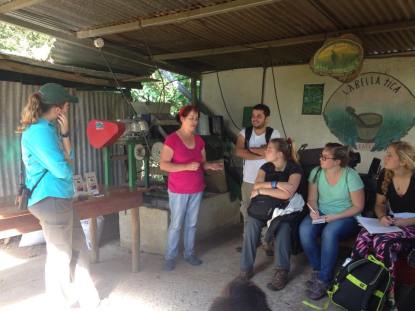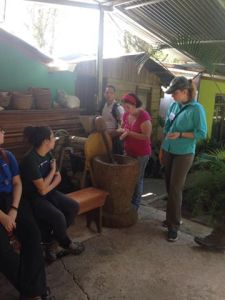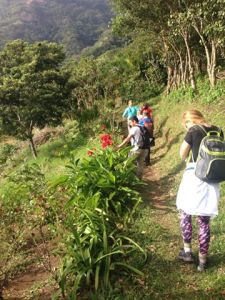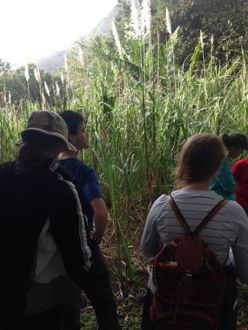In the morning we leave Liberia and travel to The University of Georgia-Costa Rica Campus. Here there is gardens and trails that you can visit. The campus is very scenic and not far from Monte Verde where we are going on a coffee tour. Below is a map of the UGACR and some pictures from their website https://dar.uga.edu/costa_rica/index.php/tourists/-/tourists
After we eat lunch we head over to Cafe San Luis at Monte Verde for a coffee tour. Below is a map of the site (https://dar.uga.edu/costa_rica/index.php/tourists/-/tourists).
We will take a approximately 3 hour tour of the development of coffee from crop to cup. We will get to learn a little bit of the country’s history and get to talk to a local farmer.
This are some pictures from http://www.monteverdeinfo.com/cafe-monteverde-coffee-tour/
The history of this site begins in 1989 when RC Beall went on a search for coffee beans in Costa Rica. He was originally from Montana and traveled to Costa Rica in hopes of expanding his business of Coffee Trade. He then found Monteverde and paid the cost to be able to sell it’s beans in the United States. He then went on to create the “Coffee with a Cause” program which donated one dollar for every bag of coffee sold in the US to the Santa Elena Cooperative. This eventually lead to the creation of Cafe Monteverde.
As for the weather in this area this will be some of the cooler temperatures we will experience. The lows are around 60-65 degrees fahrenheit and the high around 70-65 degrees fahrenheit. There may be a small breeze but not to much rain.
OUR DAY
So our day started with breakfast at Earth University. Then we packed up and headed out on our three hour drive to UGACR and Monte Verde. Once we arrived we were a little behind schedule so we ate right away in their cafeteria and brought our bags to our bungalows. Then at 1:30 we headed out to start our coffee tour. This started with meeting our tour guide Gina who is a resident naturalist from the U.S. doing an internship at UGACR. She acted as our translator for the discussions we had with two local farmers. However, before we got to the farms Gina had to lead us on a series of what seemed like never ending trails and roads to get to there. In the end it was worth it.

Here is Lisa and the rest of the group on our walk to the first stop on the coffee tour. Michiganders aren’t used to this much elevation.
The first woman we spoke with was named Ersi and she told us about the process of the coffee from the harvested stage to the completed product. Her farm is run only by her family and they are a certified organic farm. They have two hectares that they farm on and this is probably the most they would be able to handle due to the bug infestations they get with being organic. She explained to us all the different machines that are used to wash the coffee beans, remove their skin, and toast them. It was interesting to learn that their waste water from washing the beans is used in a biodigester they have on their farm. Many people in our group also noticed the potential of using the coffee waste in an anaerobic digester like the one at Fabio at UCR. The outer cherry skins are also used on their farm. They dry the skin in the sun and feed it to their chickens or use it for compost. Even the “angel hair” that comes off the beans when they are roasted is sent to a group of women down the mountain who mix it with other components and make paper. Ersi and her family even use this paper to make the bags they put their coffee product in. This is something many ecological engineers like to see because they have a use for all their waste which helps the environment.

Ersi is the one in the pink t-shirt and here she is explaining the coffee process to us on her farm.

This is a picture of the coffee beans. They call them cherries at this stage due to their red color.

Here she is showing us how they used to remove the the skin of the coffee by using a type of grinder called a Pilon that removed the skin but does not damage the bean. Now they use a machine to do this instead.

Here is Ersi’s kitchen where she gave us a sample of her coffee and we were able to purchase some as well.
Next we went to talk with Eliza. Her family’s farm is part of Finca la Bella. This is an area of land that was divided up so that 24 families each received a part of the land to grow whatever they want on it or use it for pastures. On her property they grow coffee and sugar cane. However, they grow the sugar cane for tradition because her whole family has always grow it. So she showed us around her property where they grow coffee and sugar cane and other foods that they use in their home. She then let us make some jugo de caña from the sugar cane on their farm. It was a very interesting to see the process and to try the juice we made. It does not taste like any kind of juice we have in the U.S.

This is where Eliza’s farm was. She is in the red shirt on the right and Gina is on the left. The scenery was beautiful.

Eliza showing us how they harvest the coffee beans. They have a basket that wraps around their waist and then they tie a rope to the top of the plant that loops at the bottom for them to put around their foot. This keeps the plant at a level that is easy to pick and leaves both their hands free for picking.

This is one type of plant that they plant around the coffee plants. They plant these to protect the coffee from animals that may eat them. They want the animals to eat this plant and not the coffee plant.

This is a trapiche. We used this machine to make the jugo de caña. Normally they would use two oxen to spin the machine but we used two people from our group instead.
Once we finished our tour we came back to UGACR for dinner and then had a group discussion. Overall the day was an amazing experience from learning about the coffee processes to seeing all the scenery around monte verde and UGACR.
Sources/Links to more information:
- https://dar.uga.edu/costa_rica/index.php/tourists/-/tourists
- http://www.monteverdeinfo.com/cafe-monteverde-coffee-tour/
- http://www.griffin.uga.edu/aemn/cgi-bin/AEMN.pl?site=CRSL (weather)
- http://www.externalaffairs.uga.edu/costa_rica/
- http://www.monteverdeinfo.com/
- http://www.anywherecostarica.com/travel-guide/coffee
- http://www.reuters.com/article/2014/12/22/us-women-coffee-film-idUSKBN0K016A20141222






















January 3, 2015 at 10:21 pm
Alexis I really enjoyed your write up on the coffee and sugar cane farm. I was amazed that all parts of the coffee bean are used; very eco friendly. The pictures were awesome as well. Seeing some the equipment and processes really help me visualize how it all works. I also love the scenic and group shots.
LikeLike
January 5, 2015 at 1:05 pm
Lexi – Good report and amazing pictures!! Loved all of your blog! I was just wondering what you did when you sampled the coffee. I didn’t think you liked coffee!! — Grandma Jean
LikeLike
January 6, 2015 at 9:23 pm
I don’t really like coffee grandma but I figured im in Costa Rica at a coffee farm so I have to try at least one sip!
LikeLike
January 6, 2015 at 9:12 pm
Great blog on Monte Verde and the coffee plantations Alexis!
One aspect of this tour that really that really caught my attention was Ersi’s coffee. Ersi ran this coffee company right out of her own home with a few family members. Not only did she do this out of her own home but she was growing and producing organic coffee! The processes taken to create organic coffee are much more difficult then your regular Folgers brew. Organic coffee contains no chemicals or chemical processes. If there may be a pest or disease attacking the plant an organic alternative must be purchased to treat the problem. Like Alexis said, even the bag the coffee is in comes from the coffee bean.
Again great post Aleixs.
LikeLike
January 15, 2015 at 6:31 pm
Organic products can contain chemicals or chemical processes; however, the chemicals must be of organic source. For example, you might treat a pest on a coffee plant organically by applying a liquid (i.e., chemical) extracted from another organic plant say a rye plant. It is still a chemical just not synthetically made. There are standards for when something can be called organic or if the product is “certified” organic. There also are standards for non-organic foods. It is important to understand your food system to make “informed” purchasing decisions. Who is to say that all organic chemicals are safe? What’s the difference in nutritional value for organic versus non-organic? If you have an allergy to a food, would organic make a difference? None of these questions are easy, but certainly being more informed is good. Your “purchasing dollar” will drive the choices. Knowing where your food comes from, who produces it and how it is produced is important to your food decisions and your health.
LikeLike
January 9, 2015 at 5:30 am
Great post Alexis! 🙂
The “tapa de dulce” and sugarcane were so good!! I really enjoyed the trapiche experience!
Can you explain what does it mean to have an organic farm? What’s the difference with a non-organic farm?
-Maricruz
LikeLike